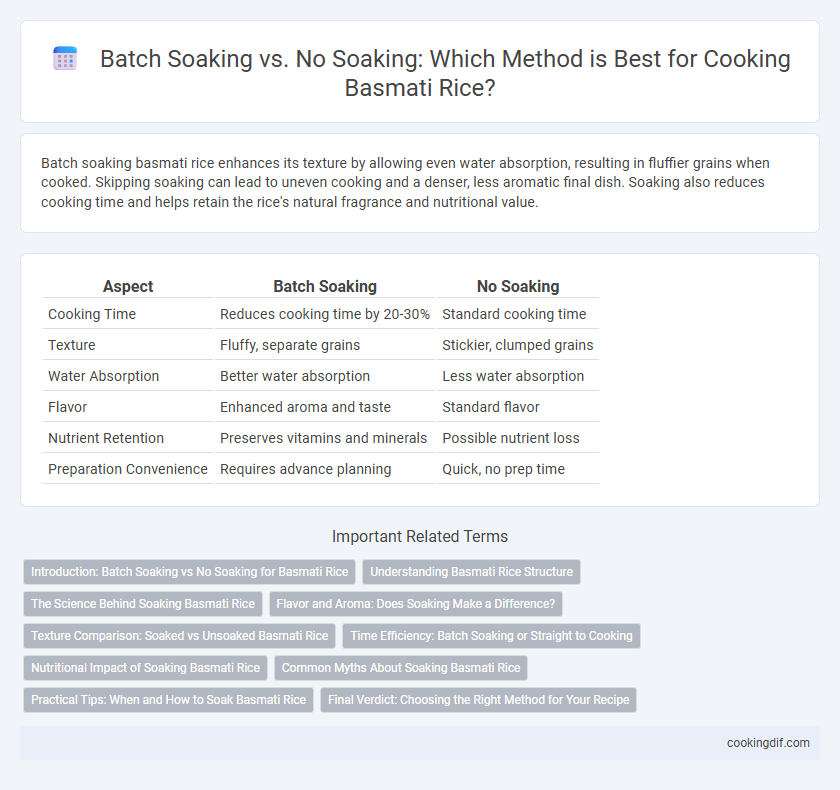Batch soaking basmati rice enhances its texture by allowing even water absorption, resulting in fluffier grains when cooked. Skipping soaking can lead to uneven cooking and a denser, less aromatic final dish. Soaking also reduces cooking time and helps retain the rice's natural fragrance and nutritional value.
Table of Comparison
| Aspect | Batch Soaking | No Soaking |
|---|---|---|
| Cooking Time | Reduces cooking time by 20-30% | Standard cooking time |
| Texture | Fluffy, separate grains | Stickier, clumped grains |
| Water Absorption | Better water absorption | Less water absorption |
| Flavor | Enhanced aroma and taste | Standard flavor |
| Nutrient Retention | Preserves vitamins and minerals | Possible nutrient loss |
| Preparation Convenience | Requires advance planning | Quick, no prep time |
Introduction: Batch Soaking vs No Soaking for Basmati Rice
Batch soaking basmati rice enhances grain texture by allowing uniform water absorption before cooking, resulting in fluffier and more evenly cooked rice. Skipping soaking leads to longer cooking times and a slightly firmer texture due to uneven hydration. The soaking process also helps reduce cooking time by roughly 20%, conserving energy and preserving the delicate aroma characteristic of basmati rice.
Understanding Basmati Rice Structure
Basmati rice grains have a unique elongated structure and a lower moisture content, making them ideal candidates for batch soaking before cooking. Batch soaking allows the grains to absorb water evenly, softening the outer bran and ensuring uniform expansion without breaking, which preserves the characteristic fluffy texture. Skipping the soaking step often results in uneven cooking, with some grains remaining hard and others overcooked, compromising the delicate structural integrity of basmati rice.
The Science Behind Soaking Basmati Rice
Soaking basmati rice hydrates the grains, allowing them to absorb moisture evenly and begin the starch gelatinization process before cooking, which results in longer, fluffier grains. This pre-cooking hydration reduces cooking time and helps achieve a more uniform texture by minimizing grain breakage. Without soaking, the rice absorbs water more slowly, often leading to uneven cooking and a stickier, less distinct grain structure.
Flavor and Aroma: Does Soaking Make a Difference?
Soaking basmati rice before cooking enhances its flavor and aroma by allowing the grains to absorb water, which results in more even cooking and a softer texture. This process releases natural starches and essential oils that intensify the distinctive nutty aroma and delicate taste characteristic of premium basmati varieties. In contrast, cooking basmati rice without soaking often leads to less aromatic and less flavorful grains due to uneven hydration and incomplete starch release.
Texture Comparison: Soaked vs Unsoaked Basmati Rice
Soaking basmati rice typically results in longer, fluffier grains with a softer texture due to better water absorption, which helps the rice cook evenly and reduces cooking time. Unsoaked basmati rice tends to have a firmer, slightly chewier texture and may cook less uniformly, leading to some grains being overcooked while others remain underdone. The choice between soaked and unsoaked rice significantly impacts the overall mouthfeel and presentation of traditional dishes like biryani and pilaf.
Time Efficiency: Batch Soaking or Straight to Cooking
Batch soaking basmati rice significantly reduces overall cooking time by allowing multiple servings to absorb water simultaneously, resulting in evenly cooked grains faster than cooking without soaking. Skipping soaking shortens prep time but extends active cooking duration as rice requires more time to soften, often leading to uneven texture. For time efficiency, batch soaking streamlines both preparation and cooking phases, optimizing the process for consistent, fluffy basmati rice.
Nutritional Impact of Soaking Basmati Rice
Soaking basmati rice before cooking reduces phytic acid content, enhancing mineral bioavailability, particularly iron and zinc absorption. This process also initiates enzymatic activity that can increase the availability of B vitamins and improve protein digestibility. Skipping soaking may retain more anti-nutrients, potentially limiting nutrient absorption despite a marginally higher calorie content.
Common Myths About Soaking Basmati Rice
Soaking basmati rice is often believed to reduce cooking time and enhance texture, but studies show that unsoaked basmati rice can achieve similar fluffiness and aroma without extended preparation. Contrary to popular myth, soaking does not significantly improve nutrient retention or remove contaminants, as basmati rice is typically polished and cleaned during processing. Choosing not to soak simplifies cooking while maintaining the characteristic long grains and delicate flavor that define basmati rice.
Practical Tips: When and How to Soak Basmati Rice
Soaking basmati rice for 30 minutes before cooking enhances grain elongation and reduces cooking time by approximately 20%, resulting in fluffier, less sticky rice. Use cold water and rinse the rice thoroughly to remove excess starch, which prevents clumping during cooking. Avoid soaking for more than 2 hours to prevent grains from becoming too soft and breaking apart.
Final Verdict: Choosing the Right Method for Your Recipe
Batch soaking basmati rice enhances texture by allowing grains to absorb water evenly, resulting in fluffier and less sticky rice, especially suitable for pilafs and biryanis. Skipping soaking saves time and works well for quick meals, but may produce slightly firmer and less aromatic rice. Selecting the right method depends on your recipe's cooking time and desired rice consistency, balancing convenience against optimal flavor and texture.
Batch soaking vs No soaking for basmati rice Infographic

 cookingdif.com
cookingdif.com